
Amanita muscaria, commonly known as the fly agaric or fly amanita, is a basidiomycete of the genus Amanita. Native throughout the temperate and boreal regions of the Northern Hemisphere, Amanita muscaria has been unintentionally introduced to many countries in the Southern Hemisphere, generally as a symbiont with pine and birch plantations, and is now a true cosmopolitan species. It associates with various deciduous and coniferous trees.
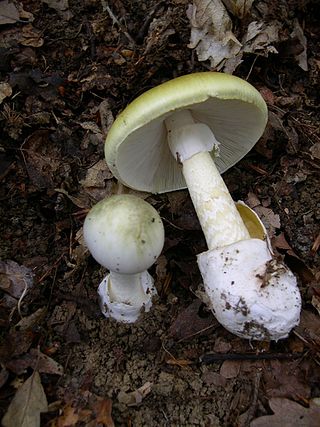
Amanita phalloides, commonly known as the death cap, is a deadly poisonous basidiomycete fungus, one of many in the genus Amanita. Widely distributed across Europe, but now sprouting in other parts of the world, A. phalloides forms ectomycorrhizas with various broadleaved trees. In some cases, the death cap has been introduced to new regions with the cultivation of non-native species of oak, chestnut, and pine. The large fruiting bodies (mushrooms) appear in summer and autumn; the caps are generally greenish in colour with a white stipe and gills. The cap colour is variable, including white forms, and is thus not a reliable identifier.

The genus Amanita contains about 600 species of agarics, including some of the most toxic known mushrooms found worldwide, as well as some well-regarded edible species. This genus is responsible for approximately 95% of the fatalities resulting from mushroom poisoning, with the death cap accounting for about 50% on its own. The most potent toxin present in these mushrooms is α-Amanitin.

Amanita porphyria, also known as the grey veiled amanita or the porphyry amanita, is a fairly common, inedible mushroom of the genus Amanita found in Europe and North America.
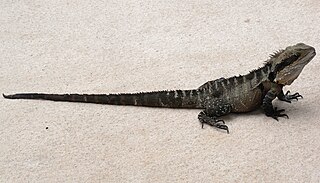
The Australian water dragon, which includes the eastern water dragon and the Gippsland water dragon subspecies, is an arboreal agamid species native to eastern Australia from Victoria northwards to Queensland. There may be a small introduced population on the south-east coast of South Australia. The Gippsland Water Dragon is generally the more southern of the two species and the more cold adapted and heat sensitive. Visually distinguishing the Gippsland Water Dragon from the Eastern Water Dragon is relatively easy, as long as their skin is reasonably clean and not stained from the water, as identification of the two subspecies depends largely on observable differences in colours and patterns.
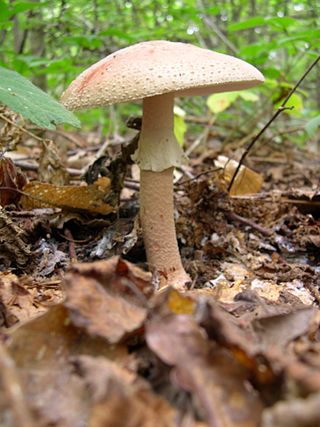
The blusher is the common name for several closely related species of the genus Amanita. A. rubescens or the blushing amanita, is found in Europe and eastern North America, and A. novinupta, also known as the new bride blushing amanita, is found in western North America. Both their scientific and common names are derived from the propensity of their flesh to turn pink on bruising, or cutting.

The vermilion grisette, also known as pretty grisette or vermilion amanita is a colourful mushroom of the genus Amanita. However, although it is often referred to by the common name "grisette", it is not closely related to other edible species that carry this common name, such as Amanita vaginata and Amanita fulva. It belongs to the same group of Amanita as A. muscaria and is reported to be toxic.

Amanita abrupta, commonly known as the American abrupt-bulbed amanita or the American abrupt-bulbed lepidella, is a deadly poisonous species of fungus in the family Amanitaceae. Named for the characteristic shape of its fruit bodies, this white Amanita has a slender stem, a cap covered with conical white warts, and an "abruptly enlarged" swollen base. This terrestrial species grows in mixed woods in eastern North America and eastern Asia, where it is thought to exist in a mycorrhizal relationship with a variety of both coniferous and deciduous tree species.

Amanita australis is a species of fungus in the family Amanitaceae. It is found only in New Zealand, where it occurs in Leptospermum and Nothofagus forest. The species was first described by New Zealand mycologist Greta Stevenson in 1962; in the same publication Stevenson also described what she thought was a unique species, Limacella macrospora, but over 30 years later this was reduced to synonymy with A. australis.
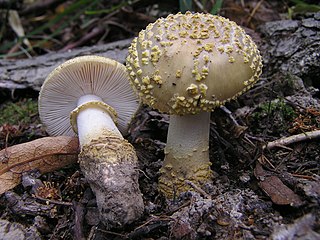
Amanita franchetii, also known as the Franchet's amanita, is a species of fungus in the family Amanitaceae. It was given its current name by Swiss mycologist Victor Fayod in 1889 in honor of French botanist Adrien René Franchet. A. franchetii occurs in Europe and North Africa with oaks, chestnuts, and pines.
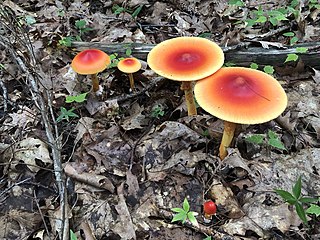
Amanita jacksonii, also known as Jackson's slender amanita, American Slender Caesar, and Eastern Caesar's Amanita, is a species of fungus in the family Amanitaceae. It is a reddish-orange colored mushroom species extending from the Province of Quebec, Canada to at least the State of Hidalgo, Mexico. It was given its current name in 1984 by Canadian mycologist René Pomerleau. It can be identified by its yellow gills, large, white, sacklike volva, and bright orange or orange-red cap, which has lined margins.

Atlanta lesueurii is a species of sea snail, a holoplanktonic marine gastropod mollusk in the family Atlantidae.

Amanita frostiana, also known as Frost's amanita, is a small fungus species of eastern U.S. and southeastern Canada. The mushroom varies in colours from yellow, red or reddish pink usually.
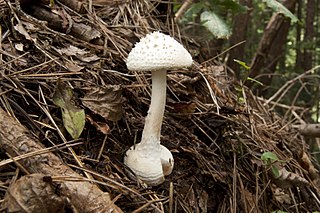
Amanita sphaerobulbosa, commonly known as the Asian abrupt-bulbed Lepidella, is a species of agaric fungus in the family Amanitaceae. First described by mycologist Tsuguo Hongo in 1969, it is found in Southern Asia. The species was formerly consider synonymous with the North American lookalike Amanita abrupta, but that species has narrower spores, a persistent partial veil, and lacks the refractive contents found in the hyphae and inflated cells of A. sphaerobulbosa.

Amanita ochrophylla is a fungus of the family Amanitaceae native to southeastern Australia. Its large and distinctive buff fruit bodies are common after rainfall.

Amanita ananiceps is a species of agaric fungus in the family Amanitaceae native to Australia.

Amanita pachycolea, commonly known as the western grisette or the Stuntz's great ringless amanita, is a species of agaric fungus in the family Amanitaceae. It was recognized as a distinct species by mycologist Daniel Elliot Stuntz, and published in 1982 by Harry Delbert Thiers. Found in western North America, it associates with conifers in coniferous and mixed forests. Amanita pachycolea is classified in Amanita section Vaginatae, which includes species with conspicuous radial striations on the cap, inamyloid spores, and the absence of a ring on the stipe. The mushroom is edible, but not recommended due to possible confusion with toxic Amanita species.

Amanita carneiphylla is a species of Amanita found in Western Australia growing among Eucalyptus, Banksia, and Allocasuarina
Allothereua lesueurii is a species of centipede in the Scutigeridae family. It is endemic to Australia. It was first described in 1840 by French entomologist Hippolyte Lucas.


















